2018 年北京清华大学考博英语真题及答案
Part Ⅰ Listening Comprehension (20 points)
Section One
Directions: In this section you will hear some people talking about how their
parents met each other and got married. Each of the conversations is followed by
an interview with one of their parents about his or her marriage. Listen to the
recording and answer the questions below with what you hear. You should use a short
sentence or a phrase for each answer. You will hear the recording only once.
1.How did Craig's parents meet each other?
2.What was his father's first impression of his mother?
What does he think now?
He still thinks so.
3.How did Dave's parents meet each other?
4.What was his mother's first impression of his father?
5.What does she think now?
6.How did Sara's parents meet each other?
7.What was her father's first impression of her mother?
What does he think now?
He still thinks so.
8.How did Lisa's parents meet each other?
9.What was her mother's first impression of her father?
10.What does she think now?
Section Two
Directions.. In this section you will hear a short lecture. Listen to the
recording and complete the notes below about the lecture. You will hear the recording
only once.
Lecture Notes
Lecture field/area:
�
11._______________________________________
Lecture Topic/Theme: Memory
Three types of memory:
12._______________________________________
13._______________________________________
14._______________________________________
Three ways of measuring memory:
15._______________________________________
16._______________________________________
17._______________________________________
Three Techniques for remembering information:
18._______________________________________
19._______________________________________
20._______________________________________
Part Ⅱ Vocabulary (10 points)
Directions: There are 20 incomplete sentences or sentences with underlined
words in this part. For each sentence there are four choices marked A, B, C and
D. Choose the best one that completes the sentence or is nearest in meaning with
the underlined word. And then mark the corresponding letter on the ANSWER SHEET
with a single line through the center.
21.Ploughs and other agricultural implements were on display at the recent
exhibition.
A.equations
B.playthings
C.tools
D.machinery
22.My own inclination, if I were in your situation, would be to look for another
position.
A.symptom
B.likeness
C.habit
D.tendency
23.The combination of lenses in a compound microscope makes possible greater
amplification than can be achieved with a single lens.
A . management
B . magnificence
C . magnetism
�
D.magnification
24.The degree of downward slope of a beach depends on its composition of deposits
as well as on the action of waves across its surface.
A.sentiment
B.sediment
C.semester
D.segment
25.The rigor of the winter in Russia was often described by Mogol.
A.harshness
B.perturbation
C.dismay
D.pessimism
26.Nowadays, the prescribed roles of the man as “breadwinner” and the woman
as housewife are changing.
A.ascribed
B.prevalent
C.original
D.settled
27.A divorcee, Tom is the sole provider in a typical “single parent” family.
A.religious
B.spiritual
C.exclusive
D.chief
28.The old woman is chronically ill in bed and seldom goes out.
A.seriously
B.dangerously
C.continually
D.incurably
29.The driver stopped his car so abruptly that he was hit by the cab right
behind him.
A.impolitely
B.violently
C.suddenly
D.maladroitly
30.Benin Mayer Alcott based the principal characters of her book Little Women
on her sisters and herself.
A.original
B.central
C.subjunctive
D.oriental
31.Largely due to the university tradition and the current academic milieu,
every college student here works ______.
A . industrially
B . industriously
C . consciously
D.purposefully
32.I don't think it's sensible of you to ______ your greater knowledge in front
of the chairwoman, for it may well offend her.
A.show up
B.show off
C.show out
D.show away
33.______, he did become annoyed with her at times.
A.Much as he liked her
B.As he liked her much
C.Although much he liked her
D.Much although he liked her
�
34.If we don't stop flirting with those deathly nuclear weapons, the whole
globe will ______.
A.empowered
B.punished
C.polluted
D.annihilated
35.One of the important properties of a scientific theory is its ability to
______ further research and further thinking about a particular topic.
A.invent
B.stimulate
C.renovate
D.advocate
36.When in his rebellious years, that is when he was sixteen or eighteen, Frank
Anderson ______ going around with a strange set of people and staying out very late.
A.took to
B.took up
C.took on
D.took in
37.In spite of the wide range of reading material specially designed or ______
for language learning purposes, there is yet no effective and systematic program
for the reading skills.
A.appointed
B.assembled
C.acknowledged
D.adapted
38.In 1816, an apparently insignificant event in a remote part of Northern
Europe ______ Europe into a bloody war.
A.imposed
B.plunged
C.pitched
D.inserted
39.The municipal planning commission said that their financial outlook for
the next year was optimistic. They expect increased tax ______.
A.privileges
B.efficiency
C.revenues
D.validity
40.The problem of pollution as well as several other issues is going to be
discussed when the Congress is in ______ again next spring.
A.convention
B.conference
C.session
D.assembly
Part Ⅲ Reading Comprehension (40 points)
Directions: There are 4 reading passages in this part. Each passage is followed
by some questions or unfinished statements. For each of them there are four choices
marked A, B,C and D. You should decide on the best choice and then mark the
corresponding letter on the ANSWER SHEET.
Passage One
Questions 41 to 45 are based on the following passage:
�
On September 7, 2001, a 68-year-old woman in Strasbourg, France, had her gall
bladder (胆囊)removed by surgeons operating, via computer from New York. It was
the first complete telesurgery procedure performed by surgeons nearly 4,000 miles
away from their patient.
In New York, Marescaux teamed up with surgeon Michel Gagner to perform the
historic long-distance operation. A high-speed fiber-optic service provided by
France Telecom made the connection between New York and Strasbourg. The two surgeons
controlled the instruments using an advanced robotic surgical system, designed by
Computer Motion Inc., that enabled the procedure to be minimally invasive. The
patient was released from the hospital after about 48 hours and regained normal
activity the following week.
The high-speed fiber-optic connection between New York and France made it
possible to overcome a key obstacle to telesurgery time delay. It was crucial that
a continuous time delay of less than 200 milliseconds be maintained throughout the
operation, between the surgeon's movements in New York and the return video (from
Strasbourg) on his screen. The delay problem includes video coding decoding and
signal transmission time.
France Telecom's engineers achieved an average time delay of 150 milliseconds.
“I felt as comfortable operating on my patient as if I had been in the room,”
says Marescaux.
The successful collaboration (合作)among medicine, advanced technology, and
telecommunications is likely to have enormous implications for patient care and
doctor training. Highly skilled surgeons may soon regularly perform especially
difficult operations through long-distance procedures. The computer systems used
to control surgical movement can also lead to a breakthrough in teaching surgical
techniques to a new generation of physicians. More surgeons-in-training will have
the opportunity to observe their teachers in action in telesurgery operating rooms
around the world.
Marescaux describes the success of the remotely performed surgical procedure
�
as the beginning of a “third revolution” in surgery within the last decade. The
first was the arrival of minimally invasive surgery, enabling procedures to be
performed with guidance by a camera, meaning that the abdomen (腹部)and thorax (胸
腔)do not have to be opened. The second was the introduction of computer-assisted
surgery, where complicated software algorithms (计算法)enhance the safety of the
surgeon's movements during a procedure, making them more accurate, while
introducing the concept of distance between the surgeon and the patient. It was
thus natural to imagine that this distance — currently several meters in the
operating room—could potentially be up to several thousand kilometers.
41.The title that best expresses the main idea is ______.
A.How The Second Revolution in Surgery Comes Out
B.The Telesurgery Revolution
C.A Patient Was Saved
D.Dream Comes True
42.The italicized word “telesurgery” (Para. 1, Sentence 2) can be best
explained as ______.
A.an operation done over a distance
B.an operation done on television
C.an operation demanding special skill
D.an operation demanding high technology
43.How long did it take the patient to resume her normal activity after the
operation?
A.24 hours
B.48 hours
C.about a week
D.almost a month
44.What is the major barrier to telesurgery?
A.distance
B.advanced technology
C.delay
D.medical facilities
45.The writer implies that ______.
A.difficult operation can be successfully performed all over the world now
�
B.compared to the “third revolution” in surgery, the first two are less
important
C.all patients can be cured by a gall bladder-removal operation
D.a new breakthrough has been made in surgery
Passage Two
Questions 46 to 50 are based on the following passage:
The multi-billion-dollar western pop music industry is under fire. It is being
blamed by the United Nations for the dramatic rise in drug abuse worldwide. “The
most worrisome development is a culture of drug-friendliness that seems to be
gaining prominence (显著) ,” said the UN's 13-member International Narcotics
Control Board in a report released in late February 1998.
The 74-page study says that pop music, as a global industry, is by far the most
influential trend-setter for young people of most cultures. “Some lyrics advocate
the smoking of marijuana (大麻) or taking other drugs, and certain pop stars make
statements and set examples as if the use of drugs for non-medicinal purposes were
a normal and acceptable part of a person's lifestyle,” the study says.
Surprisingly, says the Board, the effect of drug-friendly pop music seems to
survive despite the occasional shock of death by overdose (过量用药). “Such
incidents tend to be seen as an occasion to mourn the loss of a role model, and
not an opportunity to confront the deadly effect of ‘recreational’ drug use,”
it notes. Since the 1970s, several internationally famous singers and movie stars
—including Elvis Presley, Janice Joplin, John Belushi, Jimi Hendrix, Jonathan
Melvin and Andy Gibbs—have died of either drug abuse or drug related illnesses.
With the globalization of popular music, messages tolerating or promoting drug abuse
are now reaching beyond their countries of origin. “In most countries, the names
of certain pop stars have become familiar to the members of every household,” the
study says.
The UN study also blames the media for its description of certain drug issues
—especially the use of marijuana and issues of liberalization and legalization
�
—which encourages,rather than prevents, drug abuse. “Over the last years, we have
seen how drug abuse is increasingly regarded as being acceptable or even
attractive,” says Hamid Ghodse, president of the Board. “Powerful pressure groups
run political campaigns aimed at legalizing controlled drugs,” he says. Ghodse
also points out that all these developments have created an environment which is
tolerant of or even favorable to drug abuse and spoils international drug prevention
efforts currently underway.
The present study, focuses on the issue of demand reduction and prevention
within an environment that has become tolerant of drug abuse. The Board calls on
governments to do their legal and moral duties, and to act against the pro-drug
messages of the youth culture to which young people increasingly are being exposed.
46.Which of the following statements does the author tend to agree with?
A.The use of drugs for non-medicinal purposes is an acceptable part of a person's
lifestyle.
B.The spreading of pop music may cause the drug abuse to go beyond country
boundaries.
C.No efforts have been made to prevent the spreading of drug abuse.
D.The governments have no ability to act against the pro-drug messages of the
youth culture.
47.The italicized phrase “under fire” (Para. 1, Sentence 1) means ______.
A.in an urgent situation
B.facing some problems
C.being criticized
D.quite popular
48.Under the influence of drug-friendly pop music, what might the youth think
of the death of some pop stars caused by overdose?
A.They tend to mourn the pop stars as role models.
B.They are shocked to know even pop stars may abuse drugs.
C.They try to confront the deadly effect of “recreational” drug use.
�
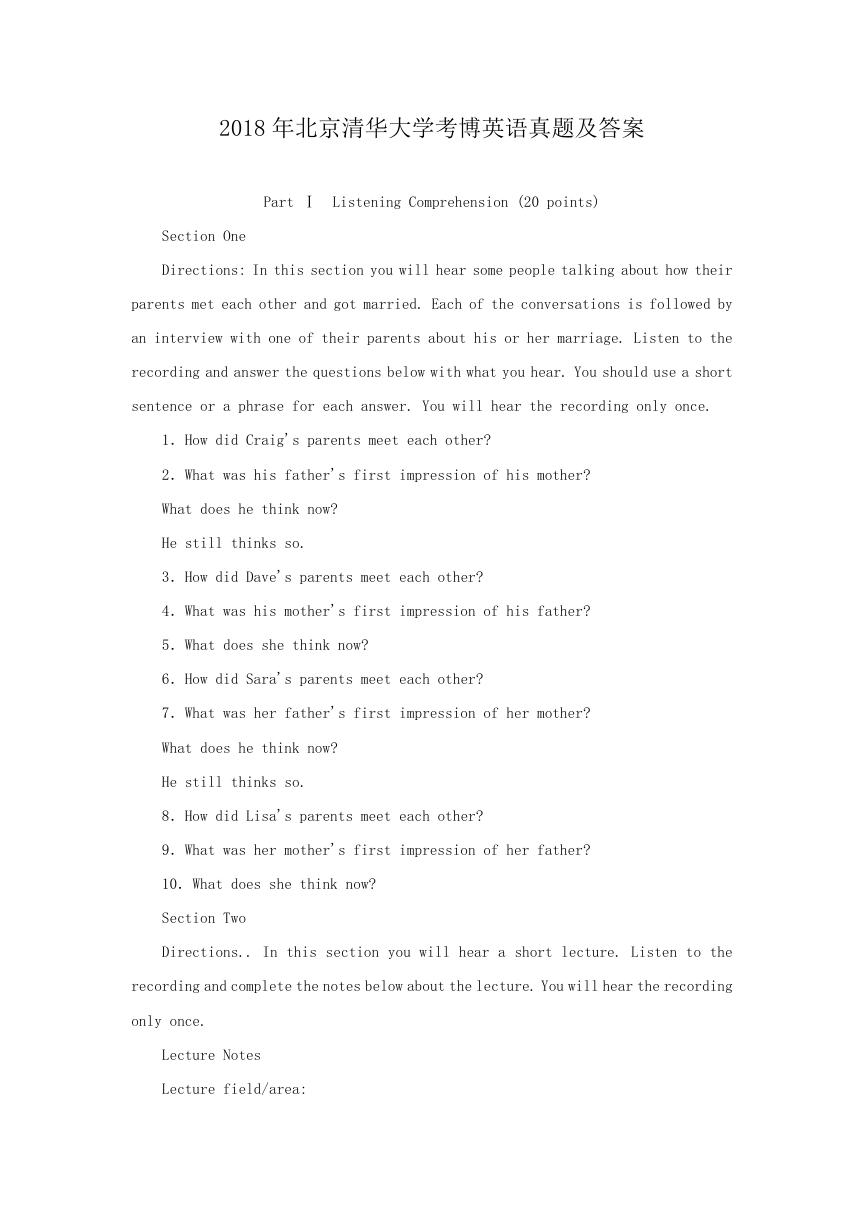
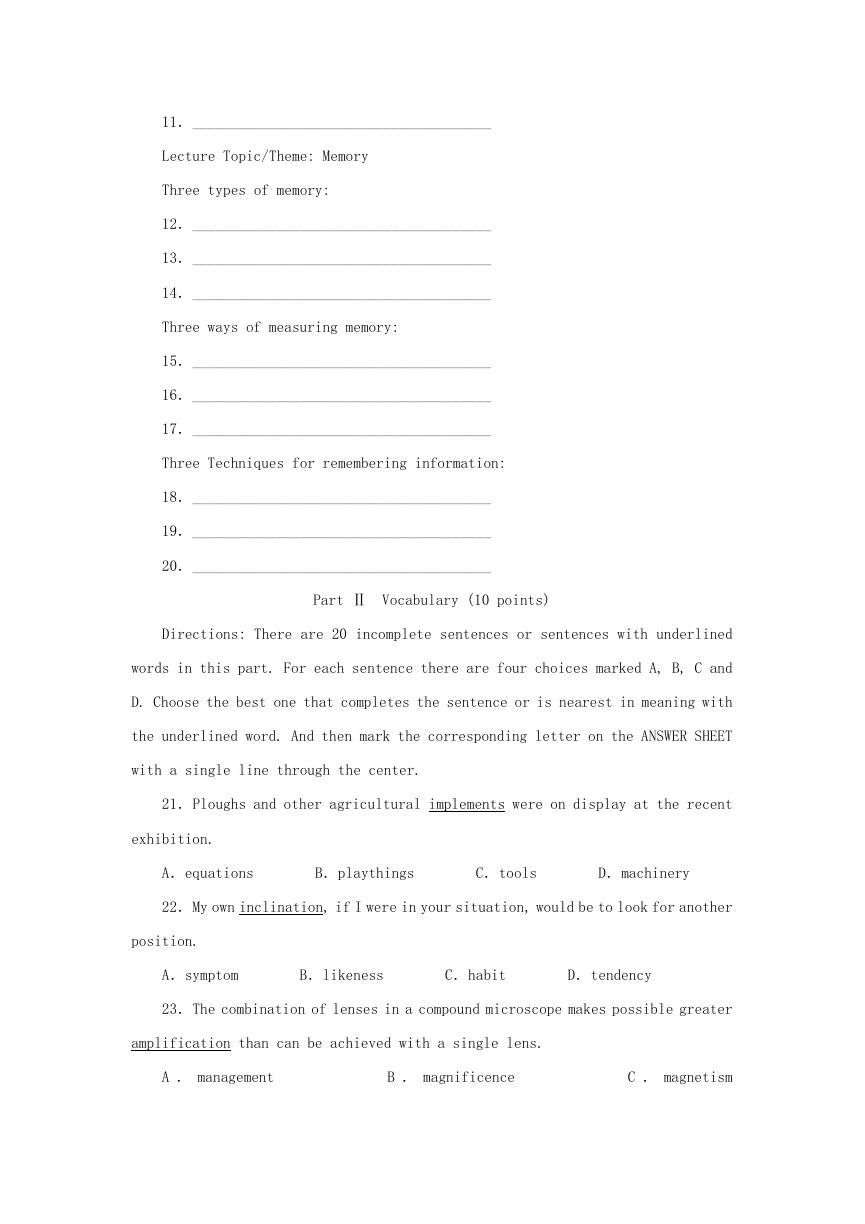
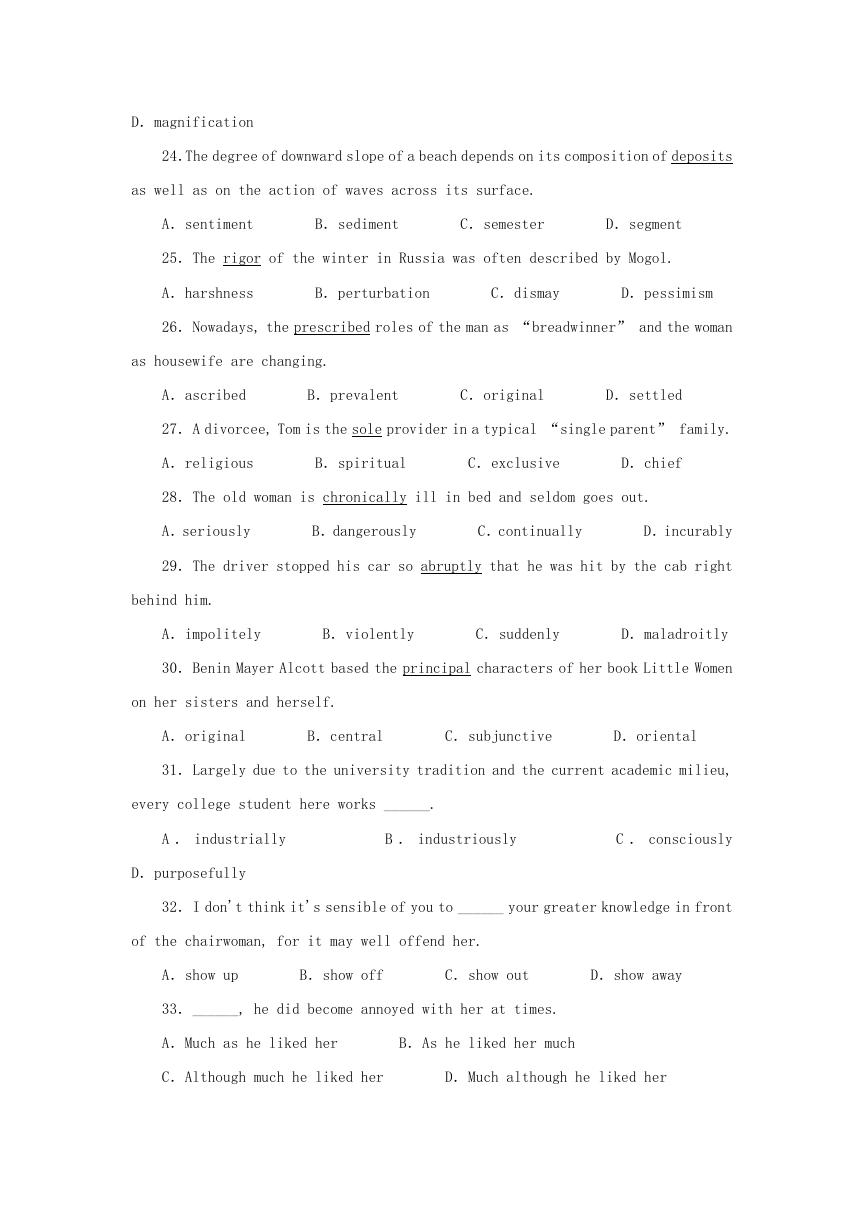

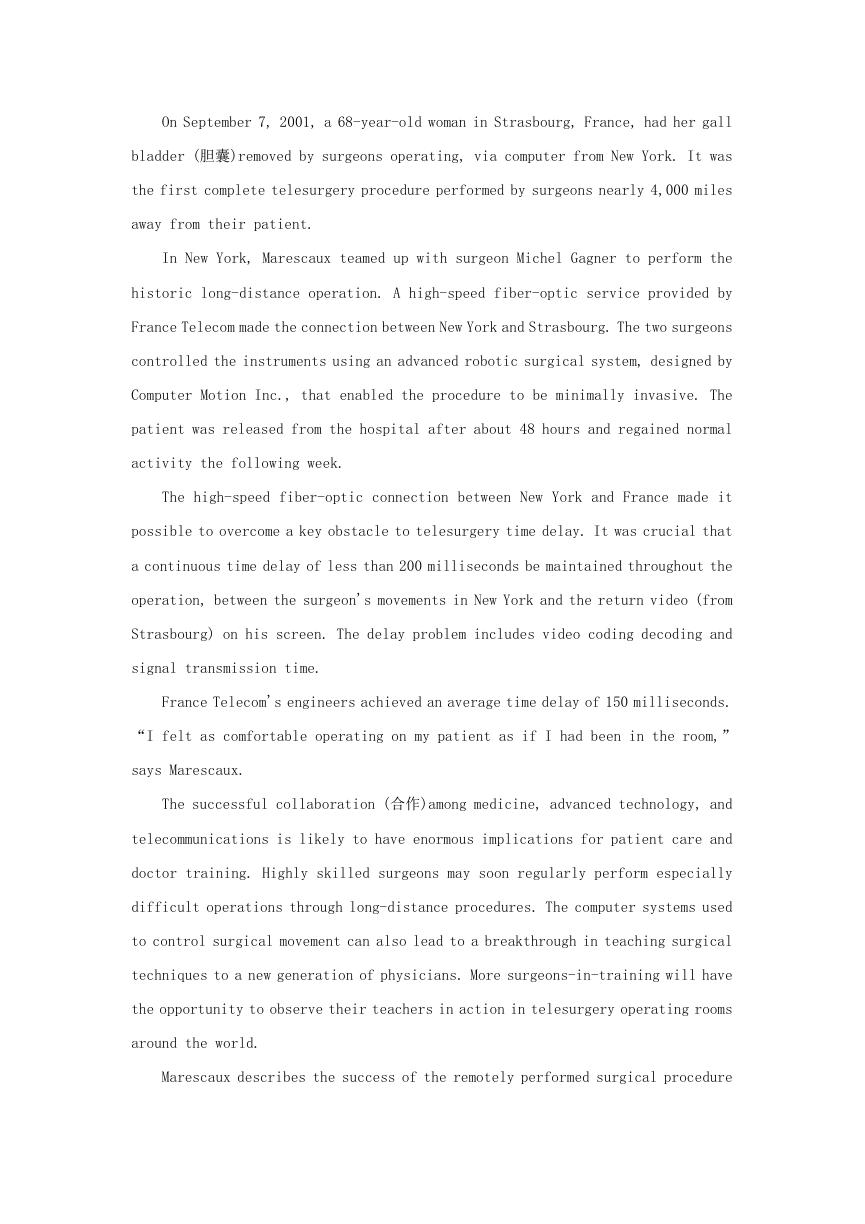
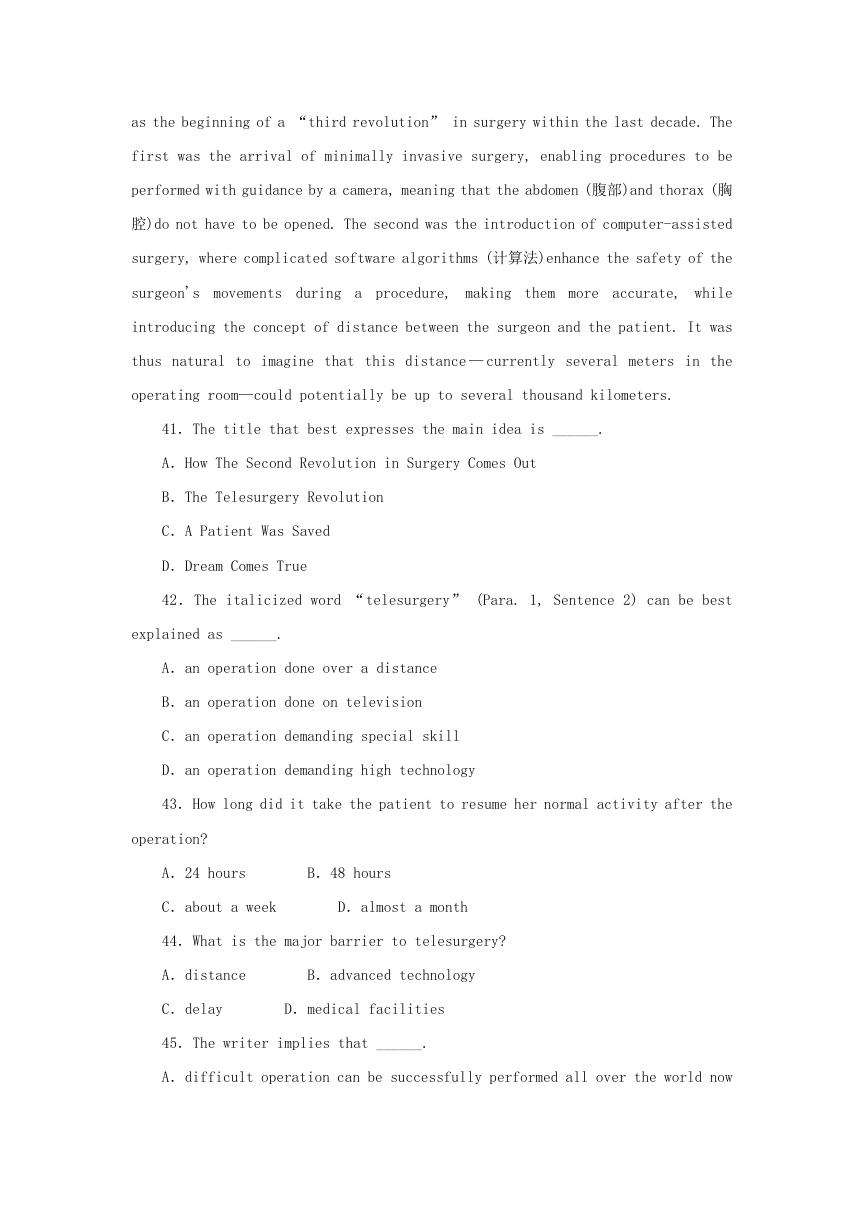

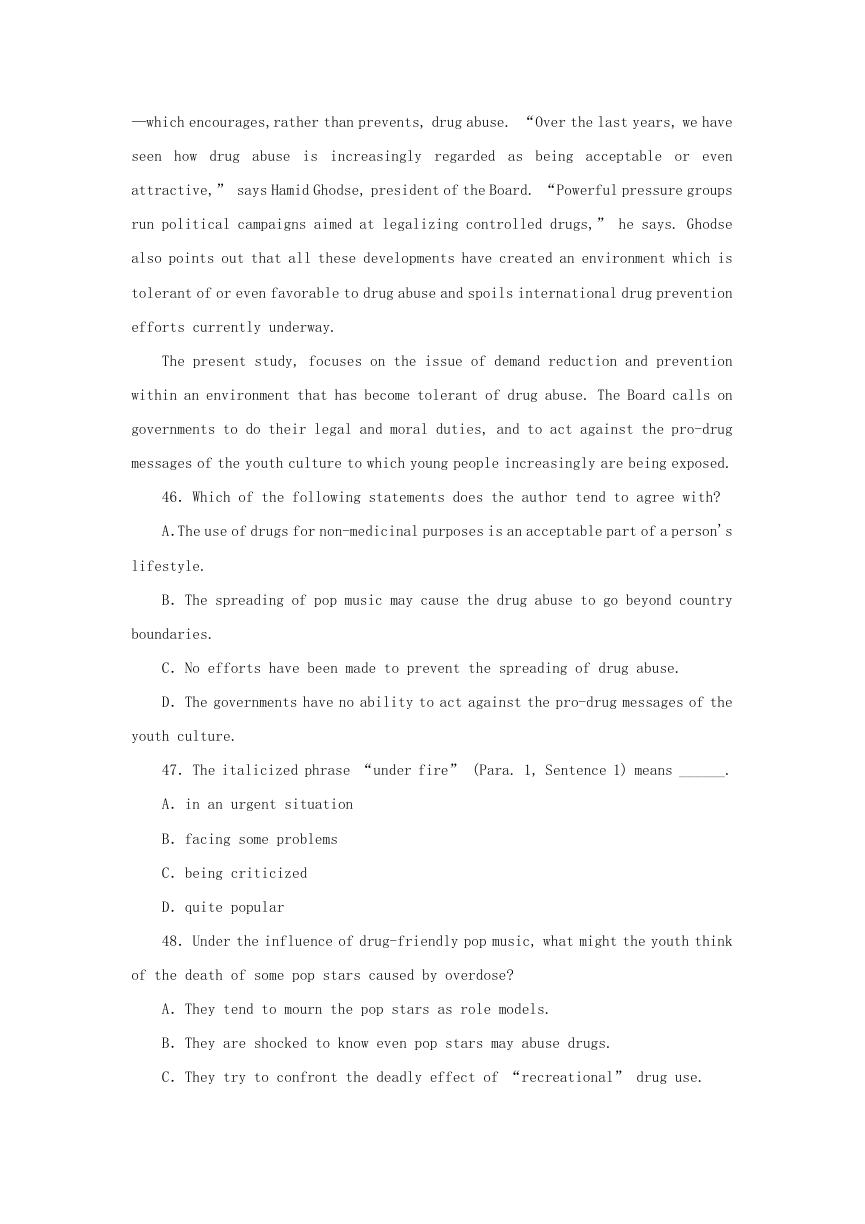








 2023年江西萍乡中考道德与法治真题及答案.doc
2023年江西萍乡中考道德与法治真题及答案.doc 2012年重庆南川中考生物真题及答案.doc
2012年重庆南川中考生物真题及答案.doc 2013年江西师范大学地理学综合及文艺理论基础考研真题.doc
2013年江西师范大学地理学综合及文艺理论基础考研真题.doc 2020年四川甘孜小升初语文真题及答案I卷.doc
2020年四川甘孜小升初语文真题及答案I卷.doc 2020年注册岩土工程师专业基础考试真题及答案.doc
2020年注册岩土工程师专业基础考试真题及答案.doc 2023-2024学年福建省厦门市九年级上学期数学月考试题及答案.doc
2023-2024学年福建省厦门市九年级上学期数学月考试题及答案.doc 2021-2022学年辽宁省沈阳市大东区九年级上学期语文期末试题及答案.doc
2021-2022学年辽宁省沈阳市大东区九年级上学期语文期末试题及答案.doc 2022-2023学年北京东城区初三第一学期物理期末试卷及答案.doc
2022-2023学年北京东城区初三第一学期物理期末试卷及答案.doc 2018上半年江西教师资格初中地理学科知识与教学能力真题及答案.doc
2018上半年江西教师资格初中地理学科知识与教学能力真题及答案.doc 2012年河北国家公务员申论考试真题及答案-省级.doc
2012年河北国家公务员申论考试真题及答案-省级.doc 2020-2021学年江苏省扬州市江都区邵樊片九年级上学期数学第一次质量检测试题及答案.doc
2020-2021学年江苏省扬州市江都区邵樊片九年级上学期数学第一次质量检测试题及答案.doc 2022下半年黑龙江教师资格证中学综合素质真题及答案.doc
2022下半年黑龙江教师资格证中学综合素质真题及答案.doc